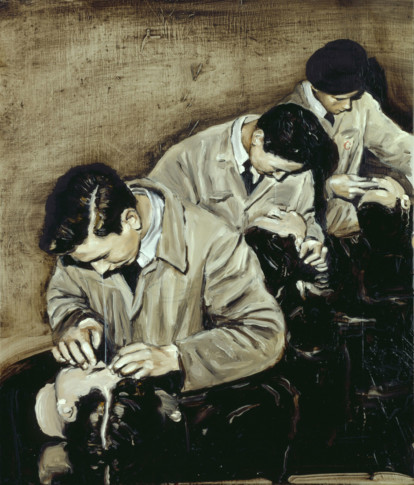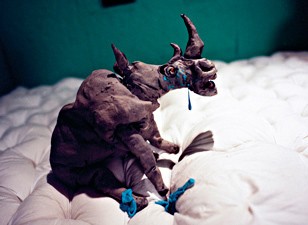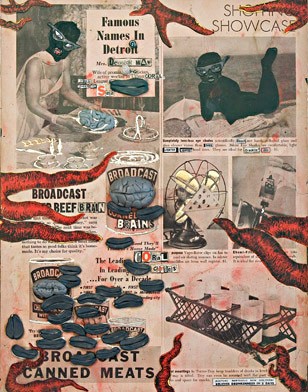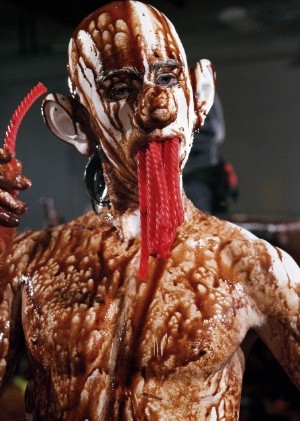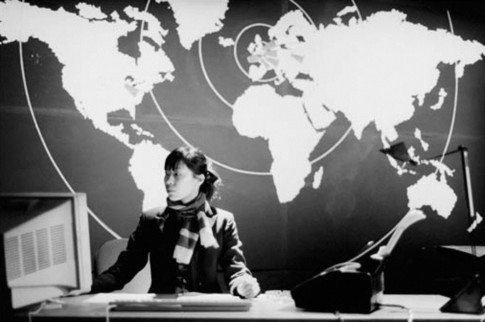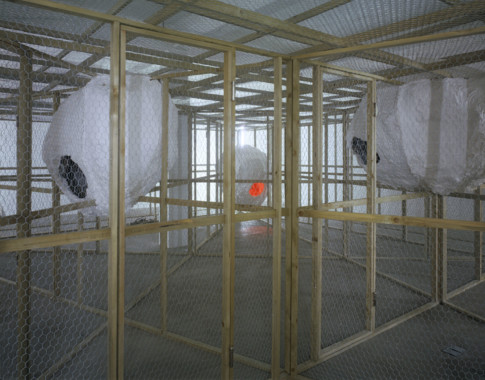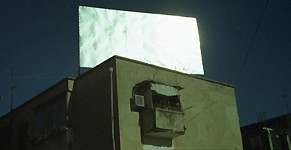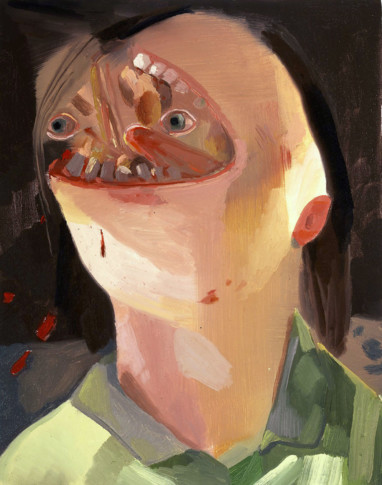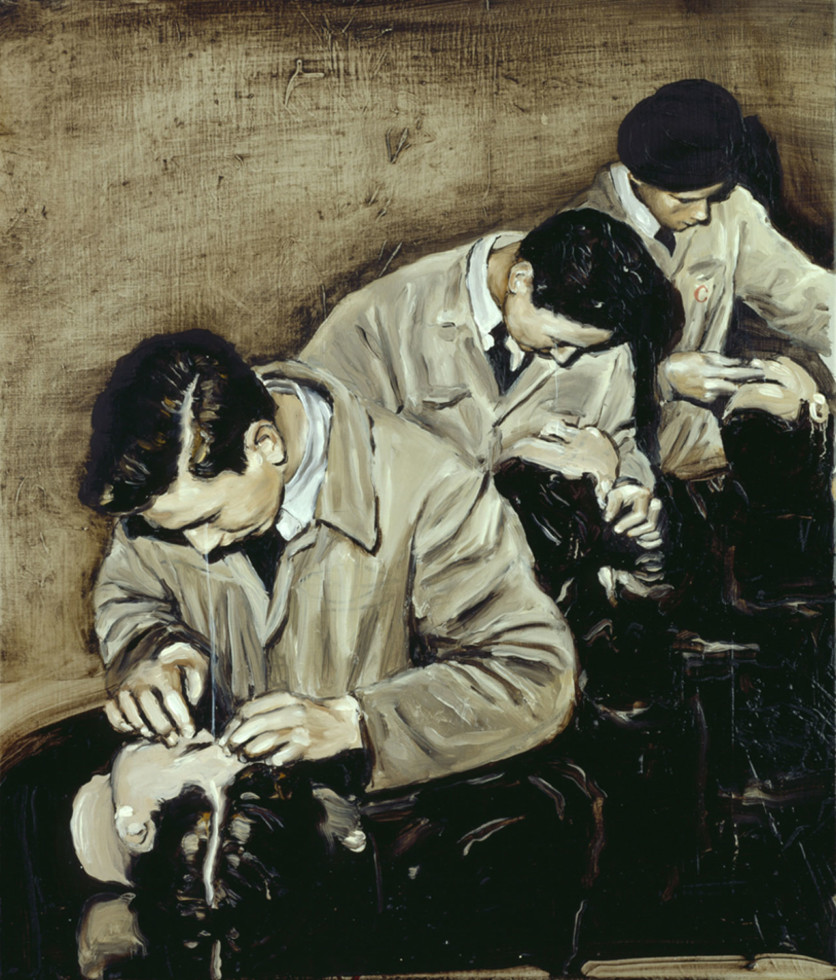
Michaël Borremans, The Pupils, 2001 70x60 cm, oil on canvas.
Courtesy Zeno X Gallery, Antwerp
Michaël Borremans
The paintings often portray people serenely absorbed, bent over some task that remains enigmatic. If they are using their hands, it is in some way that is hidden, invisible and unfathomable.
The painting The Pupils (2001) is a perfect example. The title can mean both students and the centre of the eye, an intentional double entendre. It shows three young men, sitting in a row, dressed in some kind of overalls. In their laps they each have a head over which they are bent. At first, they look like dentists, or as if they were applying makeup to the faces before them. The edges of the painting are dark and vague, but a closer look reveals that the heads appear to lack bodies and resemble the men holding them. Thin lines are drawn between the eyes of the young men and the eyes of the heads, marking the direction of the gaze or some form of transmission. The hairstyles and clothes indicate that the scene is set some time in the 1930s or 1940s, which is significant of Borremans’ paintings.
The figures in Borremans’ works are often isolated from the background, the context – without any setting that could disclose where they belong. An oppressive, uncomfortable atmosphere tends to prevail in many of the scenes. Despite their calm and concentration, they are nonetheless often bizarre and absurd. In The Advantage (2001) we see a man dressed in what appears to be a straitjacket. Is the title an irony relating to the man’s hopeless predicament, or is the artist saying that his restricted possibilities are truly an advantage? The dark humour is merciless.
The drawings and watercolours are more fantastical, more redolent of speculation and vision. While Borremans regards them as autonomous works of art in their own right, it could be said that their being drawings and sketches is thematised or emphasised so that they often appear to be ideas or drafts for future public embellishments.
Titles such as The Conman, Deception, Trickland, to mention but a few, deal with fraud, appearances and reality. The drawings especially conjure up a world of models and shadows. The problem was formulated long ago by Plato in his definition of art as depiction (mimesis). A depiction can never be identical with the depicted and is, in other words, never perfect, always defective.
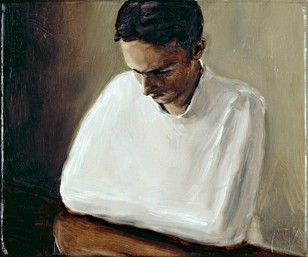
Michaël Borremans
The Advantage (Fördelen), 2001
Collection Caisa & Åke Skeppner
© Felix Tirry/Zeno X Gallery, Antwerp
A few of Borreman’s paintings and drawings evoke the scientific collections of artefacts from the past, of the exhibits in museums of natural history or educational wall charts, featuring such things as small, sawn-off birch trunks but also human beings. In these, the individuals are displayed as examples of something, not for their intrinsic value. Slight Modifications (2001) is a list of various ways to disfigure the mouth. A recurring theme is a large disc protruding from the mouth and a range of different gags. The figures are grotesque, robbed of any possibility to talk, eat or drink. The word “slight” in the title appears, again, to be a cruel irony. The scientific, objective approach seems to involve a callous indifference to human suffering. The drawings occasionally take the form of quasi-scientific illustrations on how to perform certain measures. The absurd incomprehensibility and pointlessness of the often cruel practices can be interpreted as a critique against the didactic ambitions of the Enlightenment. Twenty-three Metaphors (2001) shows a wall with immense stuffed swallows in what appears to be a museum hall. Their ability to fly, not to mention life, has been taken from them in the name of science.
Magnus af Petersens
Michaël Borremans
Born 1963. Lives and works in Ghent.
Selected solo exhibitions
2008
If It Appears in the Desert, Contemporary Fine Arts, Berlin [DE]
2007
Stand By Earth Man, Zach Feuer Gallery, New York, NY [US]
2005
The Performance, The Royal Hibernian Academy, Gallagher Academy, Dublin [IR], Parasol Unit Foundation for Contemporary Art, London [GB]
Michaël Borremans: Hallucination and Reality, The Cleveland Museum of Art, Cleveland [US]
An Unintended Performance, S.M.A.K., Ghent [BE]
2004
Zeichnungen – Drawings – Tekeningen, Museum For Gegenwartskunst, Basel [CH]
Selected group exhibitions
2006
Of Mice and Men: Berlin Biennale, KW Institute for Contemporary Art, Berlin [DE]
ARS 06, KIASMA Museum of Contemporary Art, Helsingfors/Helsinki [FI]
2005
Drawings from the Modern, 1975–2005, MOMA, New York, NY [US]
2004
Manifesta 5, European Biennale of Contemporary Art, San Sebastian [ES]
Selected bibliography
Horse Hunting, David Zwirner, New York, NY, 2006
Henrikke Nielsen, “Lucas Ajemian at Kirkhoff”, Flash Art International no 250, October 2006
Michaël Borremans: The Performance (utst.kat./exh. cat.), Patrick Murphy, Xiba de Weck, Hand Rudolf Reust, Ostfildern: Hatje Cantz Publishers, 2005
Jennifer Higgie, “Enigma Variations”, Frieze, no 89, March 2005
Michaël Borremans: Zeichnungen/Tekeningen/Drawings (utst.kat./exh. cat.), Kunstmuseum Basel – Museum für Gegenwartskunst, Cologne/Köln: Verlag der Buchhandlung Walther König, 2004


